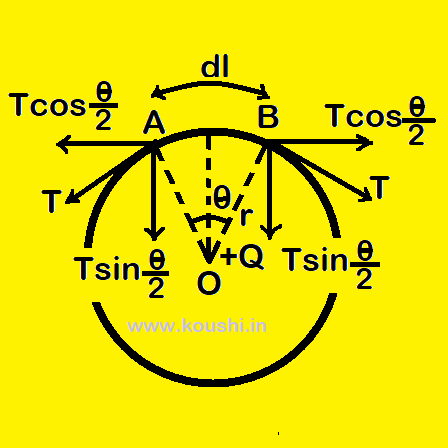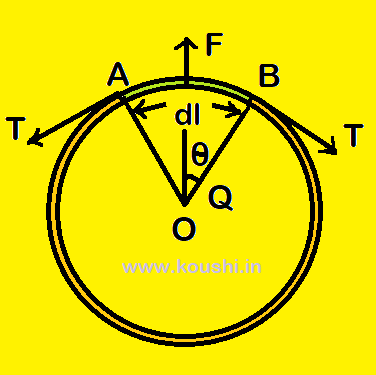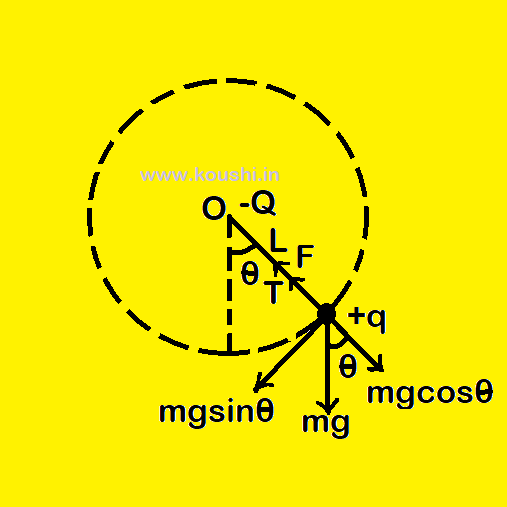1. Concept of electrostatic force:
1. Force on a point charge due to uniformly charged rod: A rod of length L is uniformly charged by Q placed at a distance D from a point charge q at P. Charge per unit length of the rod is λ = ![]() . We consider an elementary part of the rod of length dx at a distance x from P. The charge of dx is dQ =
. We consider an elementary part of the rod of length dx at a distance x from P. The charge of dx is dQ = ![]() dx.
dx.
The electric field at P due to dQ is dE = k(![]() )dx.
)dx.
So, the total electric field at P due to the entire rod is
E = ![]() dE =
dE = ![]() =
= ![]() =
= ![]() =
= ![]()
The force on charge q is F = qE = ![]() .
.

2. Tension on a charged ring: A circular ring of radius r is uniformly charged by q, so the charge per unit length is λ = ![]() . AB is the elementary part of the ring of length dl with charge dq = λdl =
. AB is the elementary part of the ring of length dl with charge dq = λdl = ![]() . A point charge Q is placed at the centre O of the ring.
. A point charge Q is placed at the centre O of the ring.
The force on AB due to Q is dF = ![]() =
= ![]() .
.
Let T is the increase in tension on the ring to balance the repulsive force. The inward tension for the part AB is 2Tsin![]() .
.
As θ is very small then, from figure ![]() =
= ![]() or, dl = rθ.
or, dl = rθ.
Then, 2Tsin![]() =
= ![]()
Or, 2T![]() =
= ![]()
Or, T![]() =
= ![]()
![]() T =
T = ![]() .
.

3. Increased radius of the ring due to excess tension: Let us consider ![]() r is the increased in radius of the ring due to excess tension. So, increased in length of the ring is
r is the increased in radius of the ring due to excess tension. So, increased in length of the ring is ![]() (r +
(r + ![]() r) – 2πr = 2π∆r.
r) – 2πr = 2π∆r.
Therefore strain = ![]() =
= ![]() . Stress =
. Stress = ![]() where A is the cross-sectional area of the ring.
where A is the cross-sectional area of the ring.
If Y is the Young’s modulus of the material of the ring then, Y = ![]() =
= ![]()
Or, ![]() r =
r = ![]() =
= ![]() [F =
[F = ![]() ].
].

4. Vertical circular motion of a charged ball: A ball of mass m charge q is tied at one end of an insulated thread of length L. The other end of the thread is connected with a fixed charge -Q. The minimum horizontal speed is required at the top point of the vertical circular motion of the ball is u. The electrostatic force between two charges is F = ![]() .
.
The force on the ball at an angle θ with vertical is T + F – mgcos![]() =
= ![]() v2
v2
Where T is the tension of the string and v is the speed at that instant.
At the top most point T = 0 and θ = 1800 so, ![]() u2 = F + mg or, u =
u2 = F + mg or, u = 
If the minimum tangential speed at the lowest point is v then, ![]() mu2 + mg2L =
mu2 + mg2L = ![]() mv2
mv2
Or, ![]() mv2 =
mv2 = ![]() m[L(
m[L( ![]() + g)] + 2mgL
+ g)] + 2mgL
Or, v =  .
.
Tension at the lowest point is T = ![]() v2 + mg – F = 6mg.
v2 + mg – F = 6mg.

Click the button to go to the next part of this chapter.
Click the button to go to the previous part of this chapter.
